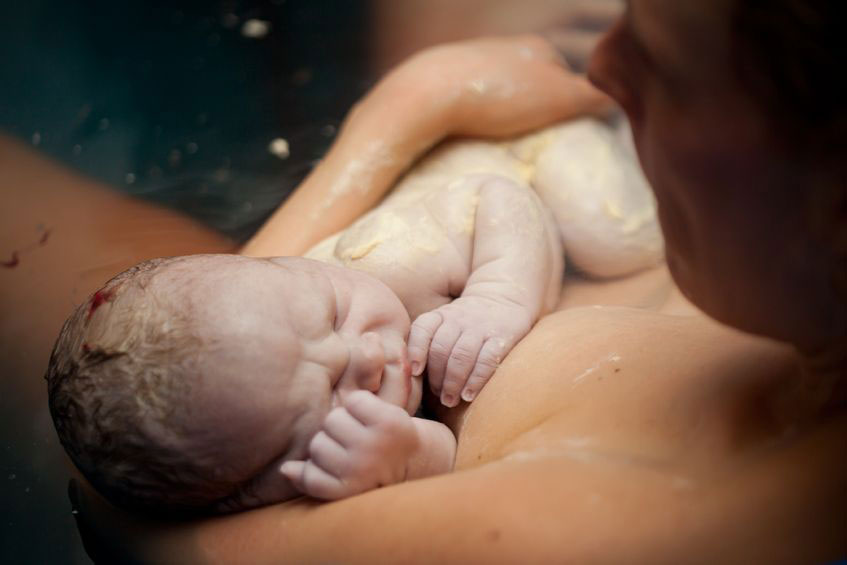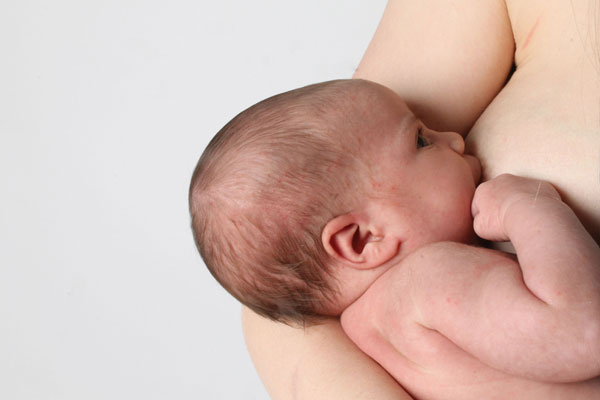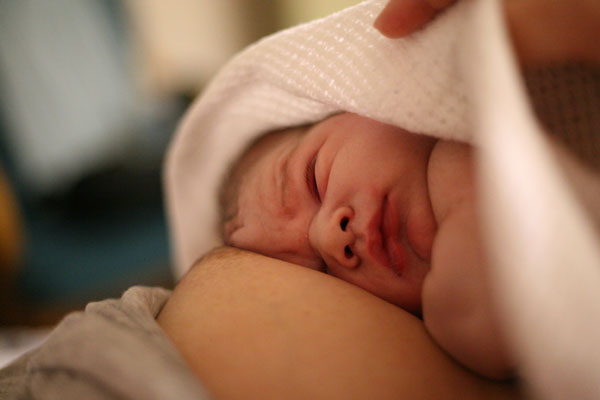When learning a new skill it helps to know the secrets to success and common pitfalls. Learning how to breastfeed is no exception. The best way to get ready for breastfeeding is to find out as much as you can about how breastfeeding works so you are well prepared. Knowing what you need, how often your baby might feed, whether they need one breast or two, or who to call if there is a problem can all help breastfeeding run smoothly. This article shares some general breastfeeding tips for newborns and is a companion article to A Good Start to Breastfeeding.

Getting ready—what you need and what you don’t
Contrary to advertising claims, breastfeeding doesn’t require much at all in the way of equipment apart from a breast, or two! A selection of non essential items that are often marketed to assist breastfeeding in some way are discussed below.
- A breast pump. A pump is not an essential purchase. Milk can be removed from the breast by hand expression. For help deciding if you need one see Do I Need a Breast Pump?
- A breastfeeding pillow. A commercial breastfeeding pillow is not a necessity. They can interfere with good positioning and can sometimes make breastfeeding more difficult—see Do I Need a Breastfeeding Pillow?
- Breastfeeding clothes. Specially marketed breastfeeding clothes are not necessary as it is possible to breastfeed in everyday clothes apart from a few items such as dresses with rear fastening.
- Nursing bras and breast pads. Some mothers choose to wear a nursing bra and some don’t see Nursing Bras FAQ. And some mothers find they leak from the opposite breast while they are feeding at first so find breast pads useful.
- A wrap or ring sling. A baby sling or wrap1 to carry your baby can be useful to keep baby close while having a hand free, especially if you have other children to look after.
- Dummies (pacifiers). Pacifiers are imitation breasts and may confuse a baby’s sucking technique and affect breastfeeding negatively. Using a dummy can cause a baby’s hunger cues to be missed which can affect his milk consumption and weight gain. Studies link dummies with fewer breastfeeds, shorter overall duration of breastfeeding, dental caries, poor teeth alignment and increased risk of infections. For more information see our article Pacifier, Dummy or Soother—Yes or No?
- Bottles and sterilising kits. Feeding bottles are not normally needed for the breastfed baby unless large volumes of supplement are needed or a mother plans to exclusively express. Frequent bottle feeds may make your baby reluctant to breastfeed or affect his latch, especially in the early weeks. Small volumes of supplement can be given by cup or syringe if needed. Another option to supplement is using a supplemental nursing system at breast. If you do plan to use a bottle see Best Bottle for a Breastfed Baby and try these Tips to Bottle Feed a Breastfed Baby to mimic breastfeeding as much as possible.
- Baby books. Baby books can vary in the quality of information they provide particularly about breastfeeding and baby care. Avoid any books that promise to train your baby into a routine as they undermine breastfeeding and disregard your baby’s needs. Breastfeeding friendly books include The Womanly Art of Breastfeeding, LLLI, 2010; Dr. Jack Newman’s Guide to Breastfeeding (updated edition), Jack Newman & Teresa Pitman, 2014; Breastfeeding Made Simple by Mohrbacher & Kendall-Tackett, 2010
- Breastfeeding diet. You don’t need to change your diet in order to make milk. For answers to frequently asked questions about specific foods see Best Breastfeeding Diet and Foods to Avoid and for any concerns about medications see Medications While Breastfeeding?

A natural birth helps breastfeeding
An unmedicated birth helps to get breastfeeding off to a good start because strong painkillers and epidural drugs used in childbirth can pass across the placenta to the baby and make him sleepy causing difficulty breastfeeding at first. A cesarean section will make looking after a newborn much harder as it is major surgery. Medications or surgery don’t mean breastfeeding won’t go well for you, but it’s important to know what to do if your baby doesn’t latch straight away and to know that it certainly isn’t because he doesn’t like breastfeeding. For more information on how birth can affect breastfeeding and what to do if baby won’t latch see When Baby Won’t Breastfeed or call an IBCLC lactation consultant for one-to-one help.
Hand expressing tip
Some mothers who are not at risk of premature labour choose to practice hand expressing in the last couple of weeks before the baby is born. It can be helpful to become familiar with the technique in case a baby has difficulty latching and they need to express after the birth. Some mothers store a little colostrum antenatally as well. See Expressing Colostrum Antenatally and Hand Expressing Breast Milk for much more information.
Breastfeed in the first hour after birth
After the birth, washing and weighing baby, and even cord-clamping, can wait while mother and baby get to know each other. Holding your baby in skin-to-skin contact and breastfeeding your baby within their first hour of life is very beneficial for your milk supply. The first milk in the breast—known as colostrum—is a concentrated milk which is rich in antibodies to protect a baby against infection and to seal and protect a baby’s gut. Delaying the first feed can increase a baby’s risk of low blood sugar 2.
If baby can’t latch
If baby can’t breastfeed, spending lots of time skin-to-skin will provide opportunities to latch and promote a baby’s natural feeding reflexes. Meanwhile hand expressing your colostrum and feeding baby by cup, spoon or syringe until they are ready to latch will stimulate your milk supply and keep baby well fed. See also A Good Start to Breastfeeding, When Baby Won’t Breastfeed, and How to Get Baby Back to Breast for more ideas, or call your IBCLC lactation consultant for one-to-one help.
How to breastfeed
- Crying is a late sign of hunger so offer a breastfeed at the first sign of hunger cues like fidgeting, rooting (head turning with an open mouth searching for the breast) and sucking fingers and fists. If you’re worried that He Can’t Be Hungry He Only Just Ate! …He can!
- Hold your baby so his tummy is close against your body, with his nose level with your nipple before he opens his mouth to latch. Check that his head and neck are all in one line (it’s very hard to swallow if your head is turned to one side). As he opens his mouth widely to take the breast, bring him in close to you so he can get a big mouthful of breast not just a nipple. See the articles Breastfeeding Positions for Newborns, Latching Tips and Breastfeeding Videos for help with positioning.
- Avoid holding the back of a baby’s head while he latches and feeds as his reflexes will cause him to pull back against your hand and away from the breast. Let your body take his weight so he feels safe and supported.
- Breastfeed comfortably—if breastfeeding hurts, something is wrong. If your baby only latches on the nipple instead of taking a deep mouthful of breast it will be painful. “Nipple feeding” will also be like trying to get toothpaste out of a tube by squeezing the hard nozzle i.e. you won’t get any paste (milk) until you squeeze behind the nozzle (nipple). See Why Does Breastfeeding Hurt? for more ideas and contact your IBCLC lactation consultant for help to get breastfeeding pain free.
- One breast or two? As a good general rule let your baby finish the first breast and then offer the other side at each feed. He may or may not finish the second side and then start the next feed with this same breast. See One Breast or Two Per Feed? for much more information and see Forget About Foremilk and Hindmilk if you are confused about different kinds of milk.
Further reading
- Is My Baby Getting Enough Milk?
- Breastfed Baby Poop
- How Can I Make More Breast Milk?
- What if I Have Flat Nipples, or Pierced Nipples or Breast Implants?

Frequent feeds
- Breastfeed often—the more often you feed, the more milk you will make. The first milk (colostrum) is made in just the right amounts for your baby’s little tummy, it will increase on or around the third day when your milk “comes in” just when your baby is ready for more. Breastmilk can be digested in an hour so frequent feeds are perfect for him 3. Expect your newborn to breastfeed at least 8 to 12 times in 24 hours and see How Often Should a Newborn Feed?
- Remind a sleepy baby to feed every couple of hours or 10 to 12 times in 24 hours. Hold him skin-to-skin and encourage latching on during periods of light sleep or as soon as he wakes. Use breast compression to keep him feeding and see Breastfeeding a Sleepy Baby.
- Night feeds are important—babies need frequent breastfeeds and this includes breastfeeding during the night. At night, the level of prolactin—an important hormone for milk production—is higher which helps with milk supply.4 Long periods of sleep without emptying the breasts can reduce a milk supply.
- Cluster feeds. It can be normal for babies to cluster feed i.e. seem to want to feed all the time at certain times of the day, for example during the evening and during growth spurts. The closer together the feeds, the higher the fat content of all the milk and the higher its calorific value so you can forget about foremilk and hindmilk. If your baby seems to feed and feed all day long without gaps, check that your baby is swallowing breast milk when he is at the breast and keep an eye on his weight gain incase he is not getting enough milk.
- You can’t spoil a baby—the easiest way to care for your newborn baby is to keep him close and respond to his every need. Partners can help with baby care—by cuddling, changing, or bathing baby and carrying baby in skin-to-skin contact or in a sling.
Further reading

When to get help
If you find breastfeeding painful, if your baby is getting increasingly jaundiced, if he isn’t having any dirty nappies, gaining weight or if he seems constantly unsettled; find a good breastfeeding helper or IBCLC lactation consultant.
- Pain. Breastfeeding shouldn’t hurt, if it does, seek help early and contact your IBCLC. Getting your baby latched on comfortably is important for preventing sore nipples and for stimulating a full milk supply.
- Jaundice. A certain amount of jaundice is normal but if baby isn’t doing plenty of poops to excrete the bilirubin it will be reabsorbed which is not a good thing. Express your milk and feed by spoon, cup, syringe or by finger feeding while you seek urgent help with feeding.
- Dirty nappies. Plenty of soft mustard poop is a good guide to how much milk has been drunk. If there aren’t plenty of dirty nappies each day after the first five days this could be a warning sign that your baby isn’t getting enough milk.
- Baby losing weight or not gaining weight. Although losing a little weight in the first few days is normal, your baby will soon start to gain 30g‑40g a day. If this is not happening see Baby Not Gaining Weight and contact your IBCLC lactation consultant. The sooner you get help the better for your milk supply.
Summary
Finding out as much as possible about breastfeeding before your baby is born can help to get breastfeeding off to a good start. The quality of information in books and online and even between health care professionals can vary considerably. If problems do come along, contact an IBCLC lactation consultant for help as soon as possible. Breastfeeding problems usually have breastfeeding solutions but the sooner they are addressed the easier it will be to solve them.



